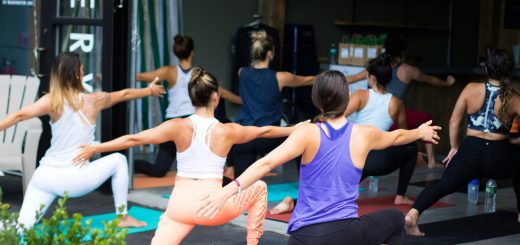Restorative Yoga: Healing Through Gentle Poses

Hey there, amazing readers! 🖐️ Just a quick note: yes, we know there are a lot of ads here. Trust us, we get it—it’s not the prettiest look, but they help us keep this blog alive and kicking. Those pesky little ads cover the costs of all the behind-the-scenes magic, from hosting and tech stuff to creating content we hope you’ll love.
We’re committed to delivering quality posts, and your support (even just sticking around despite the ads) means everything to us. So, bear with us, and thanks for helping us keep the good vibes rolling. Now, on to the fun stuff! 😉
TRANSLATE BUTTON AT THE END OF THE ARTICLE
Introduction to Restorative Yoga
Restorative yoga is a gentle and therapeutic form of yoga that focuses on relaxation and rejuvenation.
Unlike more dynamic styles of yoga that involve flowing sequences and challenging poses, restorative yoga involves holding passive poses for an extended period, typically between 5 to 10 minutes.
This extended duration allows the body to deeply relax, release tension, and activate the parasympathetic nervous system, which is responsible for the body’s rest and digest functions.
This style of yoga is perfect for individuals looking to de-stress, unwind, and restore balance in their lives.
Whether you’re dealing with chronic pain, recovering from an injury, or simply seeking a moment of calm in your hectic schedule, restorative yoga offers a sanctuary where you can slow down, reconnect with your breath, and nurture your body and mind.
Benefits of Restorative Yoga
Restorative yoga offers a myriad of benefits for both the body and mind.
Some of the key benefits include:
Stress Reduction: Restorative yoga helps lower cortisol levels, the stress hormone, promoting a sense of calm and relaxation.
Improved Sleep: By calming the mind and relaxing the body, restorative yoga can help improve the quality of your sleep.
Enhanced Flexibility: Holding passive poses for an extended period allows the muscles to lengthen and release tension, improving overall flexibility.
Pain Relief: Restorative yoga can help alleviate chronic pain conditions by promoting relaxation and reducing muscle tension.
Mental Clarity: The meditative aspects of restorative yoga can help clear the mind, improve focus, and enhance mental clarity.
How Restorative Yoga Differs
Restorative yoga differs from other styles of yoga in several key ways.
While traditional yoga practices focus on building strength, flexibility, and balance through dynamic movement and challenging poses, restorative yoga shifts the focus towards relaxation, stillness, and deep release.
In restorative yoga, props such as bolsters, blankets, blocks, and straps are often used to support the body in passive poses, allowing for a deeper sense of relaxation and comfort.
The emphasis is on surrendering to the pose, rather than actively engaging the muscles.
This approach helps activate the parasympathetic nervous system, inducing a state of deep relaxation and healing.
Unlike more vigorous forms of yoga that may leave you feeling energized and invigorated, restorative yoga leaves you feeling calm, grounded, and rejuvenated.
It is a practice that nurtures the body and mind, offering a sanctuary for self-care and introspection.
Gentle Poses for Healing
Restorative yoga incorporates a variety of gentle poses that are designed to promote healing, relaxation, and rejuvenation.
Some popular restorative yoga poses include:
Supported Child’s Pose: This pose gently stretches the back, hips, and thighs while promoting a sense of grounding and inner peace.
Supported Bridge Pose: Using a block or bolster under the sacrum, this pose opens the chest and shoulders while relieving tension in the back.
Legs-Up-the-Wall Pose: This restorative inversion helps improve circulation, reduce swelling in the legs, and promote relaxation.
Reclining Bound Angle Pose: This pose opens the hips and chest while calming the mind and relieving stress.
Corpse Pose: The ultimate relaxation pose, Corpse Pose involves lying on your back with your eyes closed, allowing the body and mind to fully relax and unwind.
Creating a Relaxing Environment
Creating a relaxing environment is essential for practicing restorative yoga effectively.
Here are some tips for setting the stage for a restorative practice:
Choose a Quiet Space: Find a quiet, clutter-free space where you can practice without distractions.
Use Soft Lighting: Dim the lights or use candles to create a soft, calming ambiance.
Play Gentle Music: Soft, instrumental music can help set the tone for relaxation and meditation.
Adjust the Temperature: Make sure the room is comfortably warm to facilitate relaxation and comfort.
Add Aromatherapy: Using essential oils like lavender or chamomile can enhance relaxation and promote a sense of calm.
Tools Needed for Restorative Yoga
To practice restorative yoga effectively, you will need a few key props to support your body in various poses.
Some essential tools for restorative yoga include:
Yoga Bolster: A bolster provides support and comfort in reclining poses, forward bends, and backbends.
Yoga Blocks: Blocks can be used to modify poses and provide support for tight muscles or limited flexibility.
Yoga Blanket: A blanket can be used for extra cushioning, warmth, or support in various poses.
Yoga Strap: Straps help with stretching and extending in poses where flexibility is limited.
Eye Pillow: An eye pillow can enhance relaxation by blocking out light and providing gentle pressure to the eyes and forehead.
Proper Alignment in Poses
Proper alignment is crucial in restorative yoga to ensure that you receive the full benefits of each pose and avoid strain or injury.
Here are some alignment tips to keep in mind:
Listen to Your Body: Pay attention to how your body feels in each pose and make adjustments as needed to find comfort.
Use Props Wisely: Props are there to support your body, so don’t hesitate to use them to find proper alignment.
Engage the Breath: Focus on deep, slow breathing to help release tension and guide your body into proper alignment.
Maintain Neutral Spine: In poses that involve lying down or sitting, keep your spine in a neutral position to avoid unnecessary strain.
Relax the Shoulders: Keep your shoulders relaxed and away from your ears to prevent tension in the neck and upper back.
Breathing Techniques in Restorative Yoga
Breathing is a fundamental aspect of restorative yoga, as it helps calm the mind, regulate the nervous system, and deepen relaxation.
Some common breathing techniques used in restorative yoga include:
Diaphragmatic Breathing: Also known as belly breathing, this technique involves breathing deeply into the belly to activate the diaphragm and promote relaxation.
Equal Breathing: Inhaling and exhaling for an equal count can help balance the nervous system and create a sense of calm.
Extended Exhalation: Lengthening the exhale can help induce relaxation and release tension in the body.
Ujjayi Breathing: This oceanic-sounding breath involves slightly constricting the back of the throat to regulate the flow of air and promote relaxation.
Nadi Shodhana: Also known as alternate nostril breathing, this breathwork technique helps balance the right and left hemispheres of the brain and calm the mind.
Tips for Beginners
If you’re new to restorative yoga, here are some tips to help you get started:
Start Slow: Begin with shorter sessions and gradually increase the duration of your practice as you become more comfortable.
Focus on Breath: Pay attention to your breath and use it as a guide to deepen your practice and relaxation.
Be Gentle with Yourself: Restorative yoga is about self-care, so be kind to your body and mind throughout your practice.
Ask for Help: If you’re unsure about a pose or how to use props, don’t hesitate to ask for guidance from a teacher or experienced practitioner.
Practice Regularly: Consistency is key in restorative yoga, so try to incorporate it into your routine on a regular basis for optimal benefits.
Precautions to Take
While restorative yoga is generally safe for most individuals, there are some precautions to keep in mind:
Injuries: If you have any existing injuries or medical conditions, consult with your healthcare provider before starting a restorative yoga practice.
Pregnancy: If you are pregnant, make sure to modify poses as needed and avoid poses that put pressure on the abdomen.
Blood Pressure: Individuals with high or low blood pressure should be cautious in inversions and consult with a healthcare provider.
Joint Pain: If you have joint pain, be mindful of your range of motion and avoid any poses that exacerbate discomfort.
Listen to Your Body: Above all, listen to your body and honor its limits.
If a pose causes pain or discomfort, ease out of it gently and adjust as needed.
Incorporating Restorative Yoga into Daily Routine
To fully embrace the healing benefits of restorative yoga, consider incorporating it into your daily routine in the following ways:
Morning Ritual: Start your day with a short restorative practice to set a peaceful tone for the day ahead.
Midday Break: Take a break during the day to recharge with a few restorative poses to combat stress and fatigue.
Evening Wind-Down: End your day with a longer restorative practice to unwind, release tension, and prepare for a restful night’s sleep.
Weekend Retreat: Dedicate some time on the weekends to indulge in a longer restorative session to relax, rejuvenate, and reset for the week ahead.
Consistency is Key: The more you practice restorative yoga, the more you will benefit from its healing effects, so aim to make it a regular part of your daily routine.
Conclusion: Embracing Restorative Yoga for Healing
In conclusion, restorative yoga offers a gentle yet powerful practice for healing the body and mind.
By incorporating passive poses, deep relaxation, and mindful breathing, restorative yoga creates a space for rejuvenation, stress relief, and inner peace.
Whether you’re a beginner looking to start a new self-care routine or an experienced yogi seeking a more calming practice, restorative yoga has something to offer everyone.
With its focus on surrender, stillness, and deep release, restorative yoga provides a sanctuary where you can slow down, tune into your body, and cultivate a sense of peace amidst the busyness of daily life.
By embracing restorative yoga as a healing practice, you can nourish your body, calm your mind, and tap into the restorative power of relaxation.
So roll out your mat, grab your props, and embark on a journey of self-discovery and healing through the gentle poses of restorative yoga.

The Enlightenment Journey is a remarkable collection of writings authored by a distinguished group of experts in the fields of spirituality, new age, and esoteric knowledge.
This anthology features a diverse assembly of well-experienced authors who bring their profound insights and credible perspectives to the forefront.
Each contributor possesses a wealth of knowledge and wisdom, making them authorities in their respective domains.
Together, they offer readers a transformative journey into the realms of spiritual growth, self-discovery, and esoteric enlightenment.
The Enlightenment Journey is a testament to the collective expertise of these luminaries, providing readers with a rich tapestry of ideas and information to illuminate their spiritual path.
Our Diverse Expertise 🌟
While our primary focus is on spirituality and esotericism, we are equally passionate about exploring a wide range of other topics and niches 🌍📚. Our experienced team is dedicated to delivering high-quality, informative content across various subjects ✨.
To ensure we provide the most accurate and valuable insights, we collaborate with trusted experts in their respective domains 🧑🏫👩🏫. This allows us to offer well-rounded perspectives and knowledge to our readers.
Our blog originally focused on spirituality and metaphysics, but we’ve since expanded to cover a wide range of niches. Don’t worry—we continue to publish a lot of articles on spirituality! Frequently visit our blog to explore our diverse content and stay tuned for more insightful reads.





